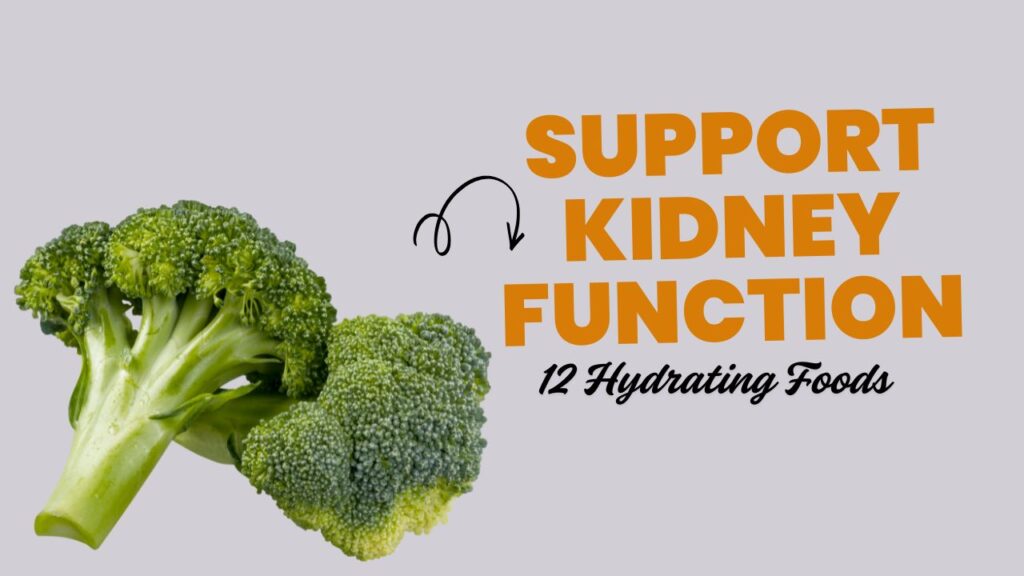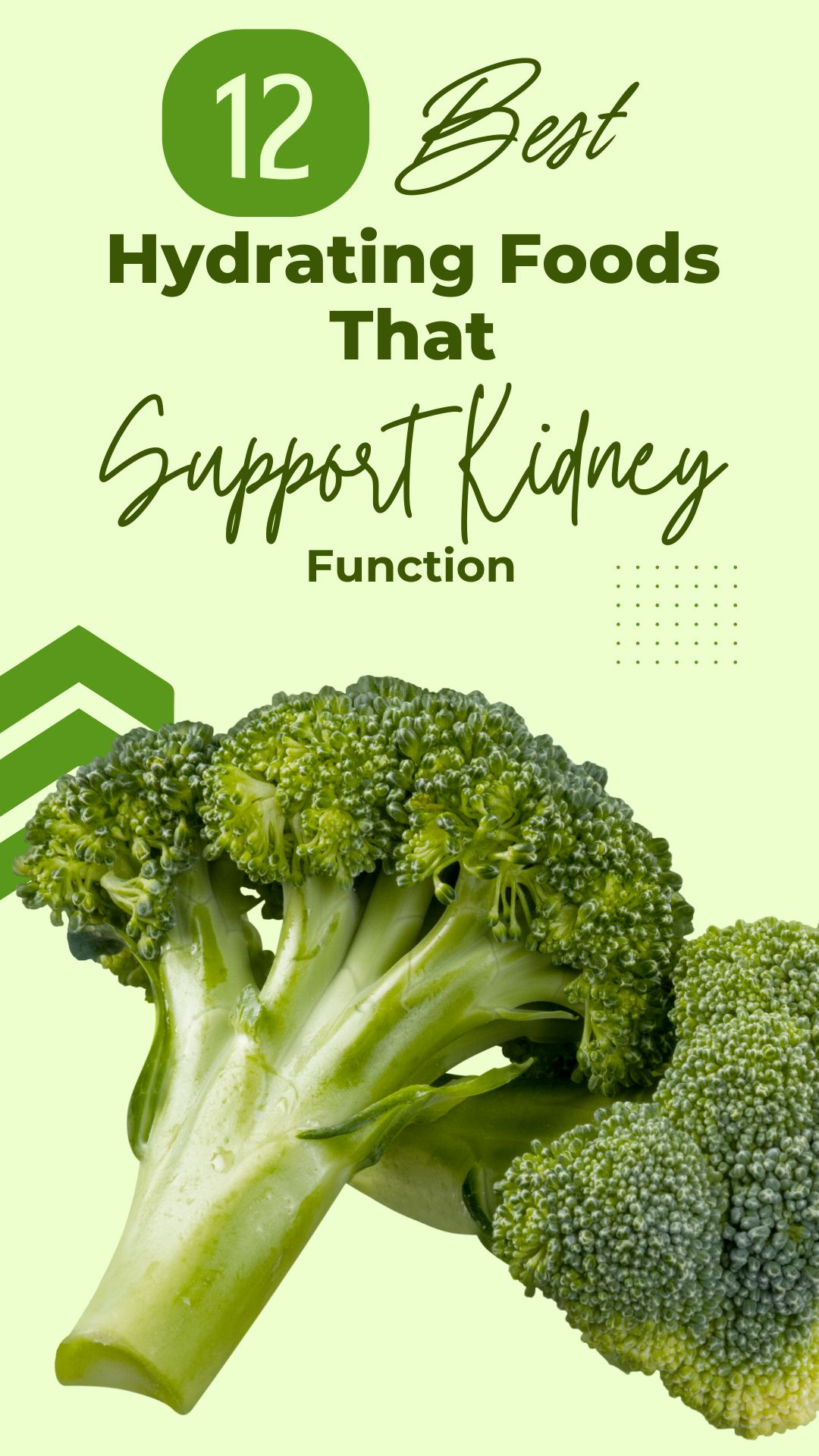Some links in this post are affiliate links. If you make a purchase through these links, I may receive a small commission. This helps support the site at no extra cost to you.
Did you know that nearly 70% of your body is water, and your kidneys are the main organs responsible for maintaining this delicate balance?
These bean-shaped organs filter waste, regulate electrolytes, and keep your body’s hydration in check. Yet, many people underestimate how much their diet can directly affect kidney health.
Struggling with low energy, puffy eyes, or frequent fatigue? Sometimes, it’s not about cutting foods out but about adding the right ones in.
The secret may lie in eating hydrating foods that not only quench your thirst but also support your kidneys in functioning at their best.
In this post, we’ll explore:
- 12 of the most hydrating foods that naturally support kidney function.
- The best ways to eat or use them.
- Who should eat or avoid them.
- Storage tips and quick do’s & don’ts.
- Possible side effects to watch for.
Let’s dive into the foods that don’t just refresh you—they actively care for your kidneys.

Table of Contents

12 Best Hydrating Foods For Kidney
1. Watermelon
Best Ways to Eat or Use It
- Fresh slices in summer.
- Blend into smoothies.
- Cube it into fruit salads.
Tips to Maximize Nutrients
Pair watermelon with a sprinkle of mint or squeeze of lime for added antioxidants.
Who Should Eat / Avoid
- Good for: People with dehydration, athletes, and those looking to lower blood pressure.
- Avoid if: You have uncontrolled diabetes, as it contains natural sugars.
Storage & Buying Tips
- Pick heavy melons with a creamy yellow spot (a sign of ripeness).
- Store whole at room temperature, but refrigerate cut pieces.
Do’s & Don’ts
| ✅ Do | ❌ Don’t |
|---|---|
| Eat chilled for hydration | Leave cut pieces uncovered in fridge |
| Pair with protein for balance | Assume it replaces water intake |
Possible Side Effects
Overeating may cause bloating or diarrhea due to its high water and fiber content.
2. Cucumber
Best Ways to Eat or Use It
- Add to detox water.
- Slice for salads or sandwiches.
- Blend into cold soups.
Tips to Maximize Nutrients
Keep the skin on for extra fiber and antioxidants.
Who Should Eat / Avoid
- Good for: People prone to kidney stones (helps flush toxins).
- Avoid if: You suffer from excessive bloating, as cucumbers may worsen it in some.
Storage & Buying Tips
- Choose firm cucumbers with dark green skin.
- Store in the fridge wrapped in a paper towel to maintain freshness.
Do’s & Don’ts
| ✅ Do | ❌ Don’t |
|---|---|
| Eat raw for max hydration | Peel skin unnecessarily |
| Use in infused water | Store near ethylene-producing fruits (like bananas) |
Possible Side Effects
May cause burping in sensitive people due to cucurbitacin compounds.
3. Oranges
Best Ways to Eat or Use It
- Fresh juice (limit to one glass).
- Whole fruit for fiber.
- Add segments to salads.
Tips to Maximize Nutrients
Pair with iron-rich foods (like spinach) to boost absorption.
Who Should Eat / Avoid
- Good for: Boosting immunity, providing vitamin C for kidney protection.
- Avoid if: You’re on potassium-restricted diets due to kidney disease.
Storage & Buying Tips
- Pick firm, heavy oranges.
- Store at room temperature for a few days or refrigerate for longer.
Do’s & Don’ts
| ✅ Do | ❌ Don’t |
|---|---|
| Eat whole for fiber | Depend only on juice |
| Mix with leafy greens | Consume in excess with kidney disease |
Possible Side Effects
Too much orange intake can lead to acid reflux or high potassium load.
4. Celery
Best Ways to Eat or Use It
- Snack with hummus.
- Add to soups and stews.
- Use in green juices.
Tips to Maximize Nutrients
Consume raw for max vitamin C and hydration benefits.
Who Should Eat / Avoid
- Good for: People with high blood pressure (natural diuretic).
- Avoid if: You have low blood pressure or are prone to diarrhea.
Storage & Buying Tips
- Look for crisp, pale-green stalks.
- Store wrapped in foil in the fridge.
Do’s & Don’ts
| ✅ Do | ❌ Don’t |
|---|---|
| Eat with dip for a snack | Overcook—it loses water |
| Use in green smoothies | Leave unwrapped in fridge |
Possible Side Effects
May interact with diuretic medications if consumed excessively.
5. Strawberries
Best Ways to Eat or Use It
- Fresh snack.
- Smoothies or yogurt bowls.
- Toss into oatmeal.
Tips to Maximize Nutrients
Eat them raw—cooking reduces vitamin C.
Who Should Eat / Avoid
- Good for: Weight management, antioxidants for kidney protection.
- Avoid if: You have a strawberry allergy.
Storage & Buying Tips
- Pick bright red berries with green caps.
- Refrigerate unwashed, wash before eating.
Do’s & Don’ts
| ✅ Do | ❌ Don’t |
|---|---|
| Eat raw for hydration | Store wet (causes spoilage) |
| Freeze for smoothies | Buy bruised berries |
Possible Side Effects
High amounts may cause digestive upset in sensitive people.
6. Spinach
Best Ways to Eat or Use It
- Salads, stir-fries, smoothies.
- Steam lightly to preserve nutrients.
Tips to Maximize Nutrients
Pair with vitamin C foods (like lemon juice) for better iron absorption.
Who Should Eat / Avoid
- Good for: Iron-deficient individuals, athletes.
- Avoid if: You have kidney stones, as spinach is high in oxalates.
Storage & Buying Tips
- Select fresh, crisp leaves.
- Store in airtight bags in the fridge.
Do’s & Don’ts
| ✅ Do | ❌ Don’t |
|---|---|
| Steam for best absorption | Overboil |
| Pair with citrus | Store wet leaves |
Possible Side Effects
Oxalates may worsen kidney stones in sensitive individuals.
7. Apples
Best Ways to Eat or Use It
- Fresh snack.
- Add slices to salads.
- Use in smoothies.
Tips to Maximize Nutrients
Keep the skin on—it holds most antioxidants.
Who Should Eat / Avoid
- Good for: Controlling cholesterol, reducing kidney stress.
- Avoid if: You’re sensitive to fructose.
Storage & Buying Tips
- Choose firm, bruise-free apples.
- Store in the fridge to prolong freshness.
Do’s & Don’ts
| ✅ Do | ❌ Don’t |
|---|---|
| Eat with skin | Peel unnecessarily |
| Store in fridge | Store with bananas (speeds ripening) |
Possible Side Effects
Too many apples can cause gas or bloating.
8. Lettuce
Best Ways to Eat or Use It
- Salads, wraps, sandwiches.
- Use as a low-carb tortilla substitute.
Tips to Maximize Nutrients
Choose darker lettuce varieties like romaine for higher nutrients.
Who Should Eat / Avoid
- Good for: Hydration, weight management.
- Avoid if: You have digestive sensitivity to raw greens.
Storage & Buying Tips
- Choose crisp, green leaves.
- Store in airtight containers with a paper towel.
Do’s & Don’ts
| ✅ Do | ❌ Don’t |
|---|---|
| Wash before eating | Store wet |
| Use as a wrap | Leave exposed to air |
Possible Side Effects
May cause digestive discomfort if eaten in large quantities raw.
9. Pineapple
Best Ways to Eat or Use It
- Fresh slices.
- Blend into smoothies.
- Add to grilled dishes.
Tips to Maximize Nutrients
Eat fresh rather than canned (canned often has added sugar).
Who Should Eat / Avoid
- Good for: Boosting digestion and hydration.
- Avoid if: You have acid reflux.
Storage & Buying Tips
- Choose pineapples with a sweet aroma.
- Store at room temp until ripe, then refrigerate.
Do’s & Don’ts
| ✅ Do | ❌ Don’t |
|---|---|
| Eat fresh | Rely on canned with syrup |
| Store in fridge when ripe | Eat unripe—it’s too acidic |
Possible Side Effects
Overconsumption may irritate the mouth or stomach.
10. Zucchini
Best Ways to Eat or Use It
- Grilled, stir-fried, spiralized into noodles.
- Add to soups.
Tips to Maximize Nutrients
Don’t peel; the skin holds antioxidants.
Who Should Eat / Avoid
- Good for: Weight management and hydration.
- Avoid if: You’re prone to digestive gas.
Storage & Buying Tips
- Select small to medium zucchinis.
- Store in the fridge in a paper bag.
Do’s & Don’ts
| ✅ Do | ❌ Don’t |
|---|---|
| Grill lightly | Overcook—it loses water |
| Use in noodles | Store too long—it softens |
Possible Side Effects
Too much can cause bloating.
11. Tomatoes
Best Ways to Eat or Use It
- Fresh in salads.
- Cooked in sauces.
- Juiced.
Tips to Maximize Nutrients
Cook with olive oil for better lycopene absorption.
Who Should Eat / Avoid
- Good for: Heart and kidney health.
- Avoid if: You’re on a low-potassium diet.
Storage & Buying Tips
- Choose firm, red tomatoes.
- Store at room temp, not fridge.
Do’s & Don’ts
| ✅ Do | ❌ Don’t |
|---|---|
| Cook with olive oil | Refrigerate—kills flavor |
| Use fresh in salads | Eat too many with reflux |
Possible Side Effects
Excess can worsen acid reflux.
12. Coconut Water
Best Ways to Eat or Use It
- Drink fresh.
- Add to smoothies.
- Use as a post-workout hydration drink.
Tips to Maximize Nutrients
Consume fresh rather than packaged for max electrolytes.
Who Should Eat / Avoid
- Good for: Athletes, dehydration recovery.
- Avoid if: You have kidney issues and need to limit potassium.
Storage & Buying Tips
- Choose young coconuts for sweeter water.
- Store fresh coconut water in the fridge.
Do’s & Don’ts
| ✅ Do | ❌ Don’t |
|---|---|
| Drink post-workout | Rely on flavored versions |
| Use in smoothies | Store unrefrigerated once opened |
Possible Side Effects
Excess can lead to high potassium levels.
Conclusion
Your kidneys silently work around the clock to filter toxins and balance fluids—yet, they’re often overlooked until problems arise.
By adding these 12 hydrating foods to your diet, you not only refresh your body but also give your kidneys the natural support they deserve.
From water-packed cucumbers to mineral-rich coconut water, every choice you make can either ease or burden your kidneys.
Why not start today? Try including one of these foods in your next meal, and notice the difference in your energy, hydration, and overall wellness.
What’s your favorite kidney-friendly food? Share your go-to recipe or snack idea in the comments!
Frequently Asked Questions (FAQs)
Which foods are best for keeping kidneys healthy?
Foods rich in water and antioxidants, such as watermelon, cucumber, strawberries, and leafy greens, are excellent for kidney health. They hydrate the body and support natural detoxification.
Can drinking too much water harm the kidneys?
Yes, overhydration can dilute sodium levels in the blood and stress the kidneys. It’s important to drink water in moderation, depending on your activity level, age, and climate.
Are bananas good or bad for kidney function?
Bananas are high in potassium, which is beneficial for most healthy people. However, individuals with chronic kidney disease (CKD) or those on potassium-restricted diets should limit bananas.
How do hydrating foods help the kidneys?
Hydrating foods support kidney function by flushing out toxins, preventing kidney stones, and maintaining electrolyte balance. They also reduce the workload on the kidneys compared to processed foods.
Should people with kidney disease avoid oranges and tomatoes?
Yes, in many cases. Both oranges and tomatoes are high in potassium, which may be harmful if kidneys cannot filter it effectively. Always consult with a healthcare provider before including them in your diet.
Can eating spinach cause kidney stones?
Spinach is rich in oxalates, which can contribute to kidney stone formation in sensitive individuals. If you’re prone to kidney stones, it’s best to consume spinach in moderation.
Is coconut water safe for people with kidney problems?
Coconut water is hydrating and rich in electrolytes, but it also contains potassium. For those with advanced kidney disease, it may not be recommended. Seek medical advice before regular consumption.
What foods should I avoid for kidney health?
High-sodium foods, heavily processed snacks, sugary drinks, and foods high in phosphorus or potassium (for those with kidney disease) should be limited.
Can hydrating foods replace drinking water?
No, hydrating foods supplement water intake but cannot fully replace it. A balance of fluids and hydrating foods is best for kidney health.
How much fluid should I consume daily for healthy kidneys?
For most adults, 2–3 liters (8–12 cups) of fluids, including water and hydrating foods, is sufficient. Exact needs vary based on activity, climate, and health conditions.










